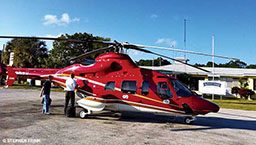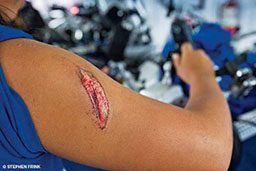Q: I work as a divemaster on a small island. Last weekend some of my coworkers went to the local chamber for “wash-out treatments,” despite not having any symptoms. We all dive a lot, but I’d never heard of anything like that before. Is that something I should do?
A: There is a misconception among some divers — particularly recreational dive professionals and fisherman divers — that a degree of tissue nitrogen saturation will occur over weeks or months of frequent diving activity. Some of these divers believe they may benefit from occasional “wash-out treatments” in a hyperbaric chamber, but that is a fallacy. Such a concept is completely at odds with all credible diving and decompression research and is inconsistent with informed clinical practice standards. Efforts to determine the origin of this misunderstanding have thus far proven unsuccessful.
Similarly, there are reports of chamber operators actually propogating this myth by offering routine “nitrogren desaturation treatments” — for a price, of course. Decompression sickness (DCS) can certainly manifest as musculoskeletal pain, so any such presentation within 24 hours of diving would warrant prompt evaluation and perhaps treatment in a chamber. However, while chronic pain has many possible causes, diving-related trapped nitrogen is not one of them.
Inert gas uptake and elimination during air, nitrox and heliox diving will obey both Dalton’s and Henry’s gas laws. Should bubbles be produced upon decompression (whether there are symptoms of DCS or not), then Boyle’s law also comes into play. Asymptomatic bubbles may remain in tissues for a day or so at most.
Throughout the compression phase of a dive and while at depth, the associated increase in inert gas pressure in the breathing gas is delivered to the diver’s lungs (Dalton’s law). From there it is gradually taken up by the blood and delivered to the body’s various tissues (Henry’s law). The rate of inert gas uptake in the blood and other tissues depends on several variables. Key among them are speed of compression, type of inert gas breathed and its related solubility coefficient, body temperature, inherent tissue perfusion and level of exercise or work load.
In recreational diving, nitrogen uptake essentially ends once the diver begins his ascent to the surface. I say “essentially” because the body’s “slower” tissues — those that are less well perfused or are supported by simple diffusion, for instance — may continue to take on nitrogen during the early and intermediate stages of ascent if their nitrogen pressures remain lower than the blood’s. Thus, nitrogen in the blood will continue to transfer into these tissues until such time that blood nitrogen levels fall to the level of those tissues. It is at this point that slower tissues will begin offgassing. This is why it is important that ascents be mostly direct and largely linear. Divers who slowly meander back to the surface may accumulate levels of nitrogen in certain tissues in excess of those assumed by decompression tables. In this way, repetitive dives can lessen the protective capabilities of the table in use.
If a diver remains at depth more than 12 to 18 hours (in a seafloor habitat or a commercial oilfield saturation-diving complex, for example), all of their tissues — fast, intermediate and slow — will re-equilibrate with nitrogen (or helium) at the new depth. This is called saturation diving. Except for tiny variations that may occur with body-temperature fluctuations, it is physiologically impossible for any additional inert gas to be taken up without further change in depth. When a diver ascends from a saturation dive, inert-gas elimination occurs in the same manner as it does at the end of a recreational dive, as described by Henry’s and Dalton’s gas laws.
Once a diver has returned to the surface, regardless of whether the dive was a short recreational dive or a long saturation dive, all tissue inert gas in excess of normal atmospheric pressure will be eliminated over the following 12 to 18 hours (i.e., his body’s tissue nitrogen levels will be re-equilibrated to the ambient atmospheric pressure). After that period, no additional nitrogen above normal atmospheric (sea-level) pressure will remain in the body.
Residual nitrogen is never “trapped” in the body, so there is absolutely no basis to treat divers for chronic nitrogen saturation. It is a misunderstanding at best, and a hoax perpetrated on divers at worst. Don’t fall for this.
— Dick Clarke, President, National Baromedical Services
Q: While vacationing in St. Maarten, I plan to do a day trip to Saba and do three dives there. I would fly out in the morning and return in the evening. The first dive would be between 90 and 130 feet deep, and the two subsequent dives would be no deeper than 80 feet. The dive operator assured me it would be safe to fly back the same day, as the aircraft would not exceed 2,000 feet during the 12-minute return flight. Would it be safe to fly in this situation, and is 2,000 feet the cutoff altitude for flying after diving?
A: You are asking about a pattern of exposure for which there is very limited empirical data. The guidelines in this low altitude range are cobbled together from a combination of expert opinion and whatever research can reasonably be applied.
Knowing that there is a high likelihood of some degree of vertical travel postdive (and no evidence of a huge problem resulting from such activity) and appreciating the implications of research data from Switzerland based on 1,700-foot exposures, the 2002 Divers Alert Network flying-after-diving guidelines stipulated a cabin altitude within the 2,000- to 8,000-foot range to qualify for flying-after-diving discussion. Lesser altitudes were excluded. Alternatively, the U.S. Navy flying-after-diving Table 9-6 (2008, Revision 6) begins with an altitude table of 1,000 feet, although it applies postdive surface-interval penalties only for high repetitive groups.

While the above may seem promising, the dives you propose to do could easily achieve extremely high postdive repetitive groups. The remaining wild cards are the flight altitude and duration. Staying below 2,000 feet may be possible, but it is certainly not guaranteed. Weather and traffic conditions might prolong flight time or result in a higher altitude. At the same time, low atmospheric pressure could increase the decompression stress of any given altitude. The person giving you the advice was describing an optimal case that may or may not reflect reality.
The overall risk in the day you describe could be acceptable, but it is certainly not a plan I would encourage or choose to do for recreation. Three dives to the depths described indicate that this would not be a low-stress day under the best conditions. The true net risk is determined by multiple factors — dive profiles, thermal stress, exertion level, between-dive surface interval, preflight surface interval, environmental conditions (weather, atmospheric pressure, geography), pilot discretion, other air traffic and individual susceptibility. The plan entails enough risk that it would not take too many factors going in the wrong direction to produce a bad day.
Safety margins could be added through the use of nitrox with a decompression algorithm set to air (but carefully respecting the maximum depth limits to avoid oxygen toxicity) and/or diving more conservative profiles and/or delaying the return time. The problem with planning such an ambitious day is that once it is set in motion it may be hard to stop. A compromise here or there or in any number of ways could easily increase the hazard.
Ultimately, you have to decide what risk you are willing to assume. Unless you are diving alone, your partner or partners would have to make similar decisions. In thinking of this, remember that decompression injuries tend to be probabilistic events. Getting away with something once, twice or 99 times does not make it safe. My advice is to focus on all the ways to increase safety margins to make diving as worry-free as an enjoyable activity should be.
— Neal W. Pollock, Ph.D.
Q: I read in a recent issue of Alert Diver (From the Medical Line, Spring 2013) that coral cannot grow under your skin, but can other sea creatures? I scraped against something while diving; the wound healed, but a couple of weeks later I noticed redness and small, painful nodules at the site of the scrape. My doctor gave me antibiotics and prednisone, which helped, but the symptoms returned after a week of treatment and now seem to be spreading. Could something be growing in me?

A: It is possible you have an infection caused by a bacterium called Mycobacterium marinum. M. marinum is a very slow-growing bacterium that requires incubation periods of two to three weeks. It is not always considered in differential diagnoses because it primarily affects those specifically exposed to aquatic environments. M. marinum infections may look like jellyfish stings at the outset, and they may get better with the use of steroids such as prednisone. Although steroids can relieve
symptoms, they do not address the cause of the infection. As the infection slowly spreads, additional nodules can appear along lymphatic pathways. Cultures for M. marinum are slightly different than standard wound cultures (e.g., requiring particular growth media), and the infection may be missed if the doctor isn’t looking for it. This bacterium is resistant to many antibiotics and generally requires specific and combination antimicrobial therapy that usually lasts for two to four months. This period includes continued antibiotics for one to two months after the infection disappears. Once treatment has begun, your primary care physician, a dermatologist or an infectious disease specialist can monitor it.
— Scott Smith, EMT-P, DMT
© Alert Diver — Q4 Fall 2013